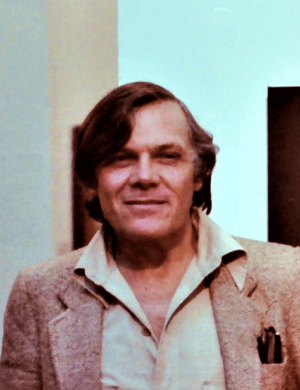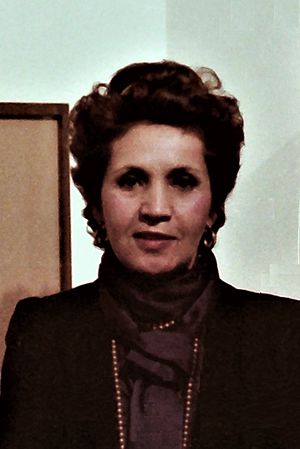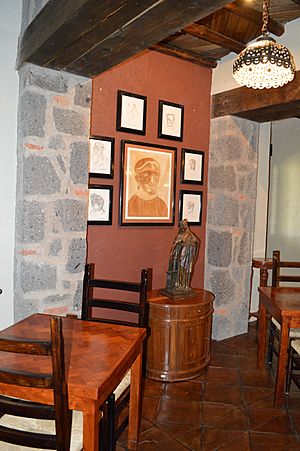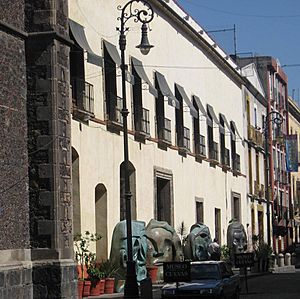José Luis Cuevas facts for kids
Quick facts for kids
José Luis Cuevas
|
|
|---|---|

José Luis Cuevas Novelo
|
|
| Born | February 26, 1934 Mexico City, Mexico
|
| Died | July 3, 2017 (aged 83) Mexico City, Mexico
|
| Nationality | Mexican |
| Occupation | painter, illustrator, printmaker, sculptor, writer |
| Movement | Modernism, Neo-figurativism, Mexican muralism |
| Awards | National Prize for Arts and Sciences of Fine Arts (1981) |
José Luis Cuevas (born February 26, 1934 – died July 3, 2017) was a very important Mexican artist. He was a talented painter, writer, draftsman, engraver, illustrator, and printmaker. Cuevas was one of the first artists to challenge the popular Mexican muralism art style. He was a key member of a group called the Generación de la Ruptura, which means "Breakaway Generation."
He mostly taught himself art. His art often showed the darker parts of life. He drew figures that looked strange or distorted. He was known for his strong opinions. He often spoke out against artists and writers he felt were involved in corruption. In 1992, the José Luis Cuevas Museum opened in Mexico City. It holds many of his artworks and his personal art collection.
Contents
About José Luis Cuevas
His Early Life
José Luis Cuevas was born on February 26, 1934, in Mexico City. His family was middle-class. He was born in a building that was a paper and pencil factory. This factory belonged to his grandfather.
When he was ten, he started studying at the National School of Painting and Sculpture "La Esmeralda". He also began drawing pictures for newspapers and books. But in 1946, he got a serious illness. He had to stay in bed for two years. During this time, he learned how to do engraving from Lola Cueto.
Starting His Art Career
At age fourteen, José Luis rented a studio space. He decided to focus on his art because of his health. He wasn't sure how long he would live. He also learned how to ride horses and weave baskets to earn money.
He drew illustrations for The News newspaper. Even without much formal training, he taught art history classes. He also visited a hospital where his brother worked. There, he drew pictures of the patients.
The Breakaway Generation
Cuevas was known for doing many self-portraits. He took a picture of himself every day starting in 1955. He continued this throughout his life. He was one of the most photographed artists in Mexico.
In the 1960s, he traveled to Morocco to study Islamic art. He met the painter Francis Bacon there. After his mother passed away in the 1970s, he became an atheist. From 1976 to 1979, he lived in France. He worked on many books and prints there. When he came back to Mexico, he had a big art show.
José Luis Cuevas passed away on July 3, 2017, in Mexico City. He was 83 years old.
His Family Life
José Luis Cuevas married his first wife, Bertha Riestra, in 1961. They met at a hospital where Bertha was doing community service. Bertha's parents did not approve of him because he was an artist. José Luis and Bertha had three daughters: Mariana, Ximena, and María Jose.
In 2000, Bertha Riestra passed away from cancer. She was the director of the José Luis Cuevas Museum at the time. The next year, he met Beatriz del Carmen Bazán. They got married in 2003 at the museum.
Cuevas and Beatriz lived in the San Ángel area of Mexico City. Their house was built for Cuevas in the 1970s. It had gray walls and straight lines. The inside was simple, with his paintings and Mexican textiles. His art studio was often messy, filled with books, old machines, and photographs.
His Art Exhibitions
José Luis Cuevas had a career that lasted over seventy years. He was a painter, writer, draftsman, engraver, illustrator, and printmaker. His artworks were shown in museums and galleries all over the world.
His first art show was when he was only fourteen. But his first successful show was in Mexico City in 1953. He was nineteen then. In 1954, he showed his art in Washington, D.C. This show sold out on the first night. It led to interviews with Time and The Washington Post. This helped him become famous and sell his paintings. In the 1950s, he also showed his art in Havana, Caracas, Lima, and Buenos Aires.
In the 1960s, he had an exhibition at the David Herbert Gallery. The NY Times newspaper compared him to Picasso. In 1961, two of his artworks caused a problem with Spain. They were called "The Funerals of a Dictator" and "The Fall of Franco." Spain asked for them to be removed from the show.
In the 1970s, he showed 72 self-portraits at a university in Mexico. He also had exhibitions in San Francisco, Caracas, Phoenix, Paris, and Mexico City. In 1976, he had four women get tattoos of his original designs. He wanted the art to "grow old with him."
In 1981, he opened an exhibit called "Signs of Life." In 1982, many galleries in different cities had shows of his work at the same time. From 1984 to 1988, a series of 50 large drawings called "Intolerance" traveled to universities and museums. These drawings were inspired by a book about witches.
In the 1990s, he had more exhibitions. He created a Talavera mural in 1995. It was placed in the Zona Rosa neighborhood. In 1998, he had a big show of his drawings and sculptures in Spain. The Pablo Picasso Foundation also showed his graphic art in 1999.
He continued to show his art actively until he passed away. This was especially true in Mexico.
His Artistic Style and Impact
José Luis Cuevas mostly taught himself art because his studies were interrupted. He was part of the first group of Mexican artists after the Muralist movement. He was a key figure in the Generación de la Ruptura (Breakaway Generation) and Neo Figurativism. He was connected with famous writers like Carlos Fuentes and Octavio Paz.
Cuevas was a strong critic of the muralist movement. This movement was led by famous artists like Diego Rivera and David Alfaro Siqueiros. Cuevas believed their art was too influenced by the government. His strong opinions and art style sometimes caused problems. He faced angry reactions and threats. He was even called "il enfant terrible" (The Bad Boy) of Mexican art.
He called the muralists and the government that supported them the "nopal cactus curtain." He felt they stopped new artists and ideas. He wrote an essay against them, which was first rejected. But he later published it as "Letter to Siqueiros." He also published his critiques in other magazines. He became friends with writers who were part of a critique group.
Cuevas's art often showed dark, strange, and sad themes. He drew human figures that were distorted. His most famous works show disfigured creatures and the sadness of the modern world. He said his art showed the loneliness of people today.
He liked to draw skulls, but he said they were not just about death in Mexican culture. He preferred to draw bodies right after death. He felt they still showed human qualities. His art was influenced by German Expressionism and Romanticism. He also felt a connection to Spanish artists like Goya. His work was influenced by Spanish poetry and cities like Seville.
Some of Cuevas's influences included Goya, Picasso, and writers like Fyodor Dostoevsky. He often honored his favorite artists and writers in his drawings and prints.
Cuevas's art style was bold and often shocking. He used pen and ink, gouache, and watercolor on large sheets of paper. In many drawings, figures would turn into animals. One famous event was his "Ephemeral Mural." He created this mural and then immediately destroyed it in public. This was a challenge to the muralist movement. He also named the "Zona Rosa" neighborhood in Mexico City. He said it was "too naive to be red, but too frivolous to be white, that's why it is precisely pink."
Awards and Recognition
Cuevas received many awards for his art. In 1959, he won the International First Prize for Drawing in Brazil. He won another prize in Switzerland in 1962. In the 1960s, he also won awards in Philadelphia, Chile, and India.
In 1977, he won first prize at an art show in Puerto Rico. In 1981, he received the National Prize of Culture from Mexico. This showed that the people of Mexico accepted his art. In the 1980s, his work was shown at the Venice Biennial. He also received the Premio Nacional de Arte from the Mexican government.
In the 1990s, he received the Ordre des Arts et des Lettres from France in 1991. He was also inducted into the National System of Creators of Mexico in 1993. In 1997, he received an award from Queen Sofía of Spain.
In the 2000s, he received the Jerusalem Prize in 2007. He also won the Lorenzo the Great Prize in Italy in 2012.
Besides art awards, Cuevas also received other honors. He received honorary doctorates from several universities in Mexico and Cuba. In 1996, the leaders of the Yaqui people honored him. In 1989, the cities of Monterrey and Tijuana gave him the keys to their cities.
The José Luis Cuevas Museum
In the late 1980s, Cuevas got an old monastery building in Mexico City. He turned it into the José Luis Cuevas Museum. It opened in 1992. His first wife, Bertha, was the museum's first director until she passed away. In 2005, his second wife, Beatriz del Carmen, became the director.
The museum has over 1,860 artworks by different artists, mostly from Latin America. These artworks are rotated and shown in different rooms. One of the most important pieces is "La Giganta" ("The Giantess") by Cuevas. This large sculpture is in the central courtyard. It was made in 1991 and was inspired by a poem. The museum also has a library with many books and newspaper clippings about Cuevas's work.
Images for kids
See also
 In Spanish: José Luis Cuevas (pintor) para niños
In Spanish: José Luis Cuevas (pintor) para niños











